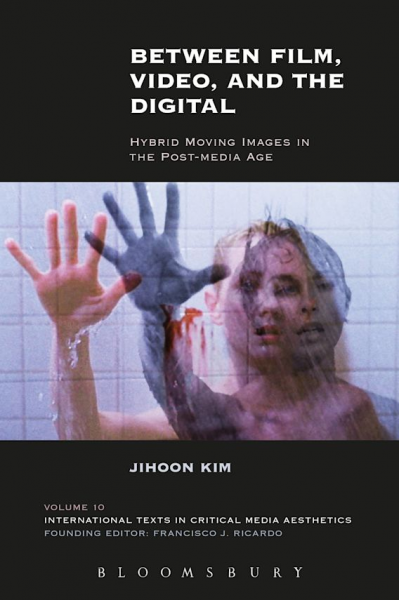
https://www.bloomsbury.com/us/between-film-video-and-the-digital-9781628922912/
Published July 14 2016
Encompassing experimental film and video, essay film, gallery-based installation art, and digital art, Jihoon Kim establishes the concept of hybrid moving images as an array of impure images shaped by the encounters and negotiations between different media, while also using it to explore various theoretical issues, such as stillness and movement, indexicality, abstraction, materiality, afterlives of the celluloid cinema, archive, memory, apparatus, and the concept of medium as such.
Grounding its study in interdisciplinary framework of film studies, media studies, and contemporary art criticism, Between Film, Video, and the Digital offers a fresh insight on the post-media conditions of film and video under the pervasive influences of digital technologies, as well as on the crucial roles of media hybridity in the creative processes of giving birth to the emerging forms of the moving image. Incorporating in-depth readings of recent works by more than thirty artists and filmmakers, including Jim Campbell, Bill Viola, Sam Taylor-Johnson, David Claerbout, Fiona Tan, Takeshi Murata, Jennifer West, Ken Jacobs, Christoph Girardet and Matthias Müller, Hito Steyerl, Lynne Sachs, Harun Farocki, Doug Aitken, Douglas Gordon, Stan Douglas, Candice Breitz, among others, the book is the essential scholarly monograph for understanding how digital technologies simultaneously depend on and differ film previous time-based media, and how this juncture of similarities and differences signals a new regime of the art of the moving image.
lntermedial Palimpsests in Lynne Sachs’s experimental documentary films
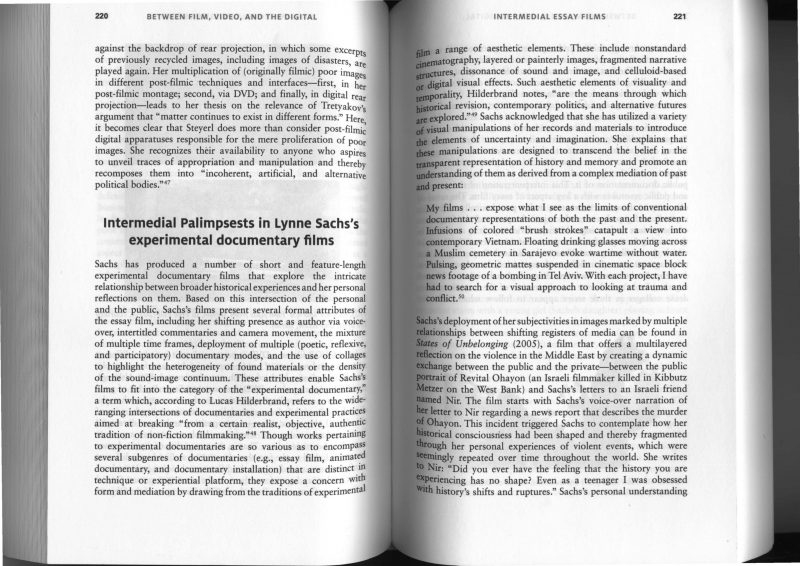
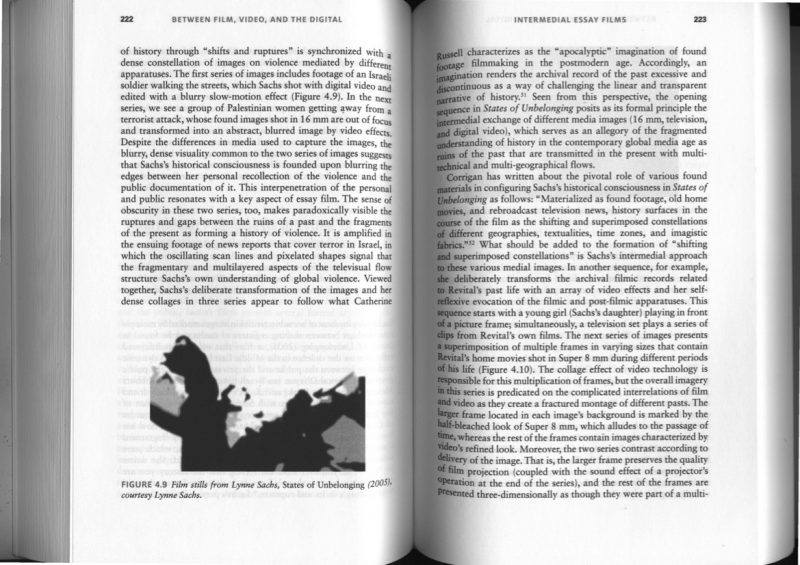
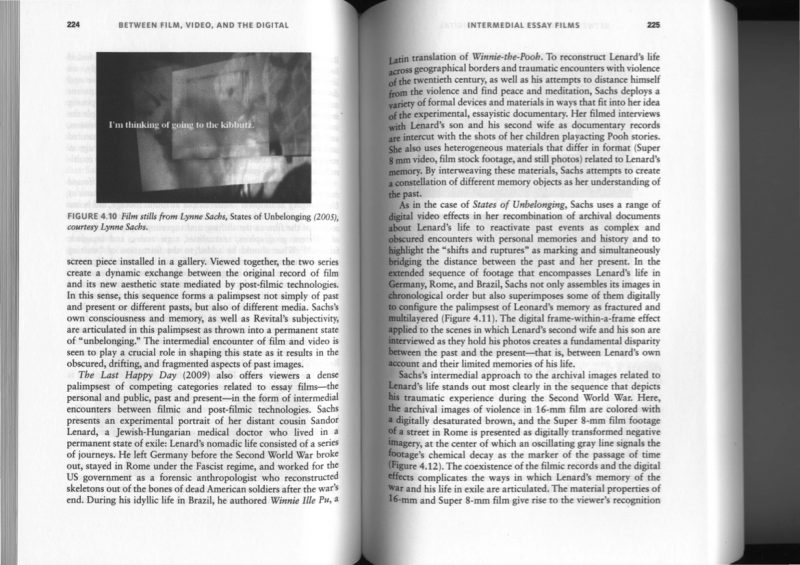
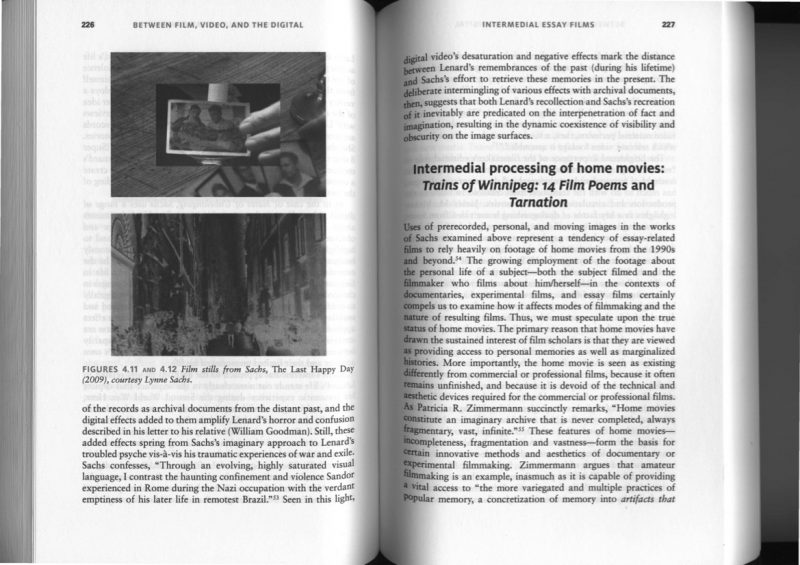
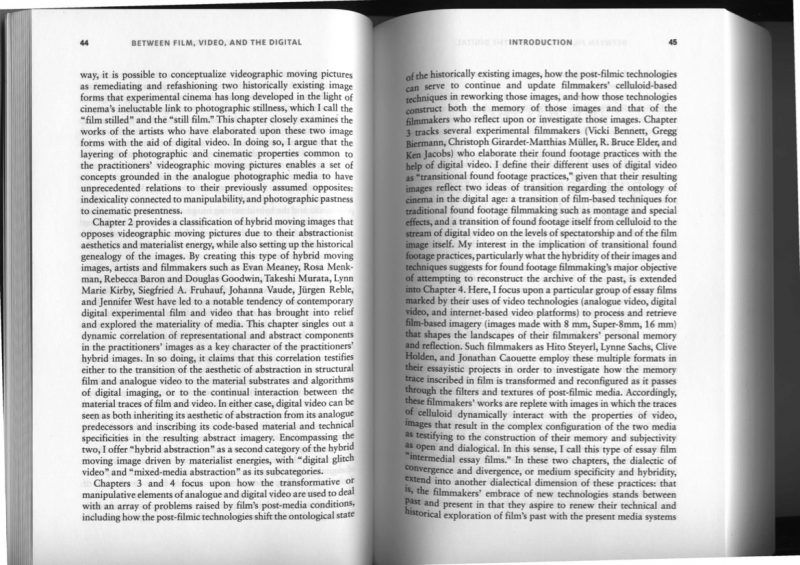
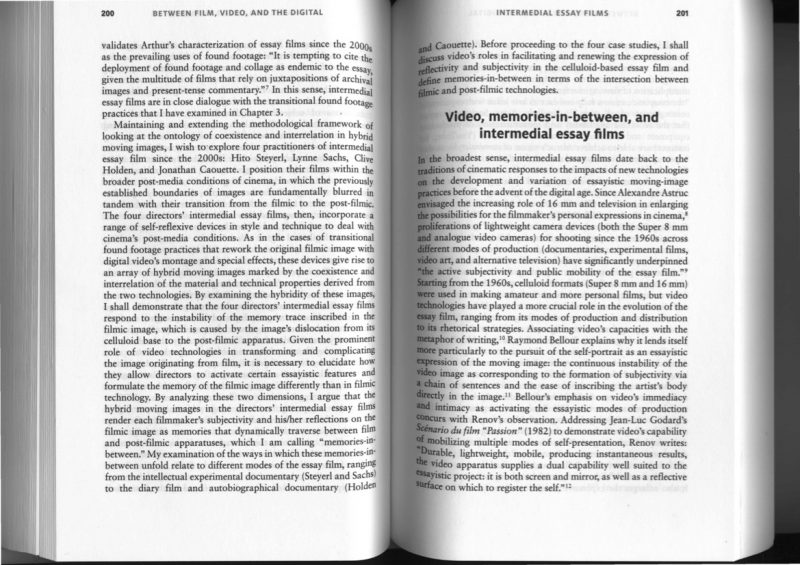
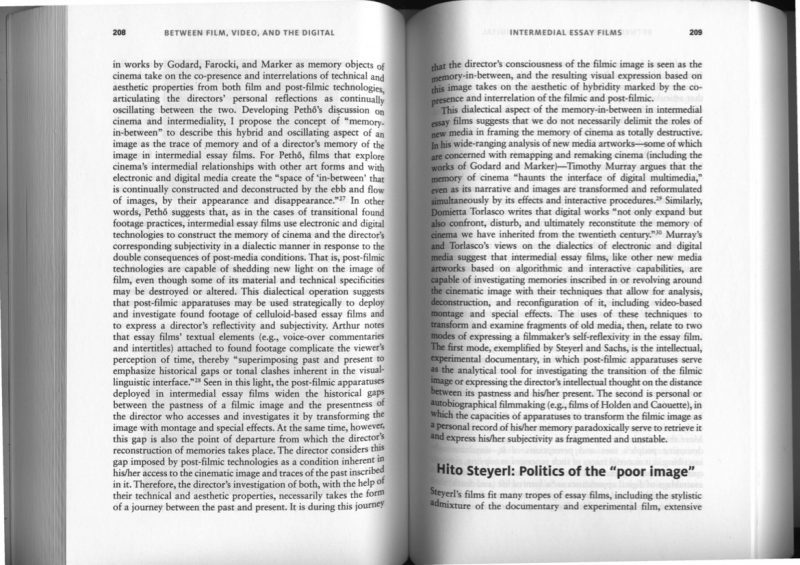
Pg. 221-227
“Sachs has produced a number of short and feature-length experimental documentary films that explore the intricate relationship between broader historical experiences and her personal reflections on them. Based on this intersection of the personal and the public, Sachs’s films present several formal attributes of the essay film, including her shifting presence as author via voice- over, intertitled commentaries and camera movement, the mixture of multiple time frames, deployment of multiple (poetic, reflexive, and participatory) documentary modes, and the use of collages to highlight the heterogeneity of found materials or the density of the sound-image continuum. These attributes enable Sachs’s films to fit into the category of the “experimental documentary,” a term which, according to Lucas Hilderbrand, refers to the wide- ranging intersections of documentaries and experimental practices aimed at breaking “from a certain realist, objective, authentic tradition of non-fiction filmmaking.” Though works pertaining to experimental documentaries are so various as to encompass several subgenres of documentaries (e.g., essay film, animated documentary, and documentary installation) that are distinct in technique or experiential platform, they expose a concern with form and mediation by drawing from the traditions of experimental film a range of aesthetic elements. These include nonstandard cinematography, layered or painterly images, fragmented narrative structures, dissonance of sound and image, and celluloid-based or digital visual effects. Such aesthetic elements of visuality and temporality, Hilderbrand notes, “are the means through which historical revision, contemporary politics, and alternative futures are explored.” Sachs acknowledged that she has utilized a variety of visual manipulations of her records and materials to introduce the elements of uncertainty and imagination. She explains that manipulations are designed to transcend the belief in the transparent representation of history and memory and promote an understanding of them as derived from a complex mediation of past and present:
My films … expose what I see as the limits of conventional documentary representations of both the past and the present. Infusions of colored “brush strokes” catapult a view into contemporary Vietnam. Floating drinking glasses moving across a Muslim cemetery in Sarajevo evoke wartime without water. Pulsing, geometric mattes suspended in cinematic space block news footage of a bombing in Tel Aviv. With each project, I have had to search for a visual approach to looking at trauma and conflict.”
Sachs’s deployment of her subjectivities in images marked by multiple relationships between shifting registers of media can be found in States of Unbelonging (2005), a film that offers a multilayered reflection on the violence in the Middle East by creating a dynamic exchange between the public and the private-between the public portrait of Revital Ohayon (an Israeli filmmaker killed in Kibbutz r on the West Bank) and Sachs’s letters to an Israeli friend ed Nir. The film starts with Sachs’s voice-over narration of her letter to Nir regarding a news report that describes the murder Ohayon. This incident triggered Sachs to contemplate how her historical consciousness had been shaped and thereby fragmented through her personal experiences of violent events, which were seemingly repeated over time throughout the world. She writes Nir: “Did you ever have the feeling that the history you are experiencing has no shape? Even as a teenager I was obsessed with history’s shifts and ruptures” Sachs’s personal understanding of history through “shifts and ruptures” is synchronized with a dense constellation of images on violence mediated by different apparatuses. The first series of images includes footage of an Israeli soldier walking the streets, which Sachs shot with digital video and edited with a blurry slow-motion effect (Figure 4.9). In the next series, we see a group of Palestinian women getting ~way from a terrorist attack, whose found images shot in 16 mm are out of focus and transformed into an abstract, blurred image by video effects. Despite the differences in media used to capture the images, the blurry, dense visuality common to the two series of images suggests that Sachs’s historical consciousness is founded upon blurring the edges between her personal recollection of the violence and the public documentation of it. This interpenetration of the personal and public resonates with a key aspect of essay film. The sense of obscurity in these two series, too, makes paradoxically visible the ruptures and gaps between the ruins of a past and the fragments of the present as forming a history of violence. It is amplified in the ensuing footage of news reports that cover terror in Israel, in which the oscillating scan lines and pixelated shapes signal that the fragmentary and multilayered aspects of the televisual flow structure Sachs’s own understanding of global violence. Viewed together, Sachs’s deliberate transformation of the images and her dense collages in three series appear to follow what Catherine Russell characterizes as the “apocalyptic” imagination of found footage filmmaking in the postmodern age. Accordingly, an imagination renders the archival record of the past excessive and discontinuous as a way of challenging the linear and transparent narrative of history. Seen from this perspective, the opening sequence in States of Unbelonging posits as its formal principle the intermedial exchange of different media images (16 mm, television, digital video), which serves as an allegory of the fragmented understanding of history in the contemporary global media age as of the past that are transmitted in the present with multi-technical and multi-geographical flows.
Corrigan has written about the pivotal role of various found materials in configuring Sachs’s historical consciousness in States of Unbelonging as follows: “Materialized as found footage, old home movies, and rebroadcast television news, history surfaces in the course of the film as the shifting and superimposed constellations of different geographies, textualities, time zones, and imagistic fabrics.” What should be added to the formation of “shifting and superimposed constellations” is Sachs’s intermedial approach to these various medial images. In another sequence, for example, she deliberately transforms the archival filmic records related to Revital’s past life with an array of video effects and her self-reflexive evocation of the filmic and post-filmic apparatuses. This sequence starts with a young girl (Sachs’s daughter) playing in front of a picture frame; simultaneously, a television set plays a series of from Revital’s own films. The next series of images presents a superimposition of multiple frames in varying sizes that contain Revital’s home movies shot in Super 8mm during different periods of his life (Figure 4.10). The collage effect of video technology is responsible for this multiplication of frames, but the overall imagery in this series is predicated on the complicated interrelations of film and video as they create a fractured montage of different pasts. The larger frame located in each image’s background is marked by the half-bleached look of Super 8 mm, which alludes to the passage of time, whereas the rest of the frames contain images characterized by video’s refined look. Moreover, the two series contrast according to delivery of the image. That is, the larger frame preserves the quality of film projection (coupled with the sound effect of a projector’s operation at the end of the series), and the rest of the frames are presented three-dimensionally as though they were part of a multi-screen piece installed in a gallery. Viewed together, the two series create a dynamic exchange between the original record of film and its new aesthetic state mediated by post-filmic technologies. In this sense, this sequence forms a palimpsest not simply of past and present or different pasts, but also of different media. Sachs’s own consciousness and memory, as well as Revital’s subjectivity, are articulated in this palimpsest as thrown into a permanent state of “unbelonging.” The intermedial encounter of film and video is seen to play a crucial role in shaping this state as it results in the obscured, drifting, and fragmented aspects of past images.
The Last Happy Day (2009) also offers viewers a dense palimpsest of competing categories related to essay films-the personal and public, past and present-in the form of intermedial encounters between filmic and post-filmic technologies. Sachs presents an experimental portrait of her distant cousin Sandor Lenard, a Jewish-Hungarian medical doctor who lived in a permanent state of exile: Lenard’s nomadic life consisted of a series of journeys. He left Germany before the Second World War broke out, stayed in Rome under the Fascist regime, and worked for the US government as a forensic anthropologist who reconstructed skeletons out of the bones of dead American soldiers after the war’s end. During his idyllic life in Brazil, he authored Winnie Ille Pu, a latin translation of Winnie-the-Pooh. To reconstruct Lenard’s life .aoss geographical borders and traumatic encounters with violence of the twentieth century, as well as his attempts to distance himself from the violence and find peace and meditation, Sachs deploys a variety of formal devices and materials in ways that fit into her idea of the experimental, essayistic documentary. Her filmed interviews withLenard’s son and his second wife as documentary records are intercut with the shots of her children playacting Pooh stories. Shealso uses heterogeneous materials that differ in format (Super 8 mm video, film stock footage, and still photos) related to Lenard’s memory. By interweaving these materials, Sachs attempts to create a constellation of different memory objects as her understanding of the past.
As in the case of States of Unbelonging, Sachs uses a range of digital video effects in her recombination of archival documents about Lenard’s life to reactivate past events as complex and obscure encounters with personal memories and history and to highlight the “shifts and ruptures” as marking and simultaneously bridging the distance between the past and her present. In the extended sequence of footage that encompasses Lenard’s life in Germany, Rome, and Brazil, Sachs not only assembles its images in chronological order but also superimposes some of them digitally to configure the palimpsest of Leonard’s memory as fractured and multilayered (Figure 4.11). The digital frame-within-a-frame effect applied to the scenes in which Lenard’s second wife and his son are interviewed as they hold his photos creates a fundamental disparity between the past and the present-that is, between Lenard’s own account and their limited memories of his life.
Sachs’s intermedial approach to the archival images related to Lenard’s life stands out most clearly in the sequence that depicts his traumatic experience during the Second World War. Here, the archival images of violence in 16-mm film are colored with a digitally desaturated brown, and the Super 8-mm film footage of a street in Rome is presented as digitally transformed negative imagery, at the center of which an oscillating gray line signals the footage’s chemical decay as the marker of the passage of time (Figure 4.12). The coexistence of the filmic records and the digital effects complicates the ways in which Lenard’s memory of the war and his life in exile are articulated. The material properties of 16-mm and Super 8-mm film give rise to the viewer’s recognition of the records as archival documents from the distant past, and the digital effects added to them amplify Lenard’s horror and confusion described in his letter to his relative (William Goodman). Still, these added effects spring from Sachs’s imaginary approach to Lenard’s troubled psyche vis-a-vis his traumatic experiences of war and exile. Sachs confesses, “Through an evolving, highly saturated visual language, I contrast the haunting confinement and violence Sandor experienced in Rome during the Nazi occupation with the verdant emptiness of his later life in remotest Brazil.”53 Seen in this light, digital video’s desaturation and negative effects mark the distance between Lenard’s remembrances of the past (during his lifetime) and Sachs’s effort to retrieve these memories in the present. The deliberate intermingling of various effects with archival documents, then, suggests that both Lenard’s recollection·and Sachs’s recreation of it inevitably are predicated on the interpenetration of fact and imagination, resulting in the dynamic coexistence of visibility and obscurity on the image surfaces.
Uses of prerecorded, personal, and moving images in the works of Sachs examined above represent a tendency of essay-related films to rely heavily on footage of home movies from the 1990s and beyond. The growing employment of the footage about personal life of a subject-both the subject filmed and the filmmaker who films about him/herself-in the contexts of documentaries, experimental films, and essay films certainly compels us to examine how it affects modes of filmmaking and the nature of resulting films. Thus, we must speculate upon the true status of home movies. The primary reason that home movies have drawn the sustained interest of film scholars is that they are viewed providing access to personal memories as well as marginalized stories. More importantly, the home movie is seen as existing differently from commercial or professional films, because it often remains unfinished, and because it is devoid of the technical and aesthetic devices required for the commercial or professional films. Patricia R. Zimmermann succinctly remarks, “Home movies constitute an imaginary archive that is never completed, always fragmentary, vast, infinite.” These features of home movies- incompleteness, fragmentation and vastness-form the basis for innovative methods and aesthetics of documentary or erimental filmmaking. Zimmermann argues that amateur filmmaking is an example, inasmuch as it is capable of providing a vital access to “the more variegated and multiple practices of popular memory, a concretization of memory into artifacts…”
Pg. 44-45
“Chapter 2 provides a classification of hybrid moving images that opposes videographic moving pictures due to their abstractionist aesthetics and materialist energy,while also setting up the historical genealogy of the images. By creating this type of hybrid moving images, artists and filmmakers such as Evan Meaney, Rosa Menk- man, Rebecca Baron and Douglas Goodwin, Takeshi Murata, Lynn Marie Kirby, Siegfried A. Fruhauf, Johanna Vaude, Jurgen Reble, and Jennifer West have led to a notable tendency of contemporary digital experimental film and video that has brought into relief and explored the materiality of media. This chapter singles out a dynamic correlation of representational and abstract components in the practitioners’ images as a key character of the practitioners’ hybrid images. In so doing, it claims that this correlation testifies either to the transition of the aesthetic of abstraction in structural film and analogue video to the material substrates and algorithms of digital imaging, or to the continual interaction between the material traces of film and video. In either case, digital video can be seen as both inheriting its aesthetic of abstraction from its analogue predecessors and inscribing its code-based material and technical specificities in the resulting abstract imagery. Encompassing the two, I offer “hybrid abstraction” as a second category of the hybrid moving image driven by materialist energies, with “digital glitch video” and “mixed-media abstraction” as its subcategories.
Chapters 3 and 4 focus upon how the transformative or manipulative elements of analogue and digital video are used to deal with an array of problems raised by film’s post-media conditions, including how the post-filmic technologies shift the ontological state of the historically existing images, how the post-filmic technologies canserve to continue and update filmmakers’ celluloid-based techniques in reworking those images, and-how those technologies construct both the memory of those images and that of the filmmakers who reflect upon or investigate those images. Chapter 3 tracks several experimental filmmakers (Vicki Bennett, Gregg Biermann, Christoph Girardet-Matthias Muller, R. Bruce Elder, and KenJacobs) who elaborate their found footage practices with the help of digital video. I define their different uses of digital video as “transitional found footage practices,” given that their resulting images reflect two ideas of transition regarding the ontology of cinema in the digital age: a transition of film-based techniques for traditional found footage filmmaking such as montage and special effects,and a transition of found footage itself from celluloid to the stream of digital video on the levels of spectatorship and of the film image itself. My interest in the implication of transitional found footage practices, particularly what the hybridity of their images and techniques suggests for found footage filmmaking’s major objective of attempting to reconstruct the archive of the past, is extended into Chapter 4. Here, I focus upon a particular group of essay films marked by their uses of video technologies (analogue video, digital video,and internet-based video platforms) to process and retrieve film-based imagery (images made with 8 mm, Super-8mm, 16 mm) that shapes the landscapes of their filmmakers’ personal memory and reflection. Such filmmakers as Hito Steyerl, Lynne Sachs, Clive Holden, and Jonathan Caouette employ these multiple formats in their essayistic projects in order to investigate how the memory trace inscribed in film is transformed and reconfigured as it passes through the filters and textures of post-filmic media. Accordingly, these filmmakers’ works are replete with images in which the traces of celluloid dynamically interact with the properties of video, images that result in the complex configuration of the two media as testifying to the construction of their memory and subjectivity as open and dialogical. In this sense, I call this type of essay film “intermedial essay films.” In these two chapters, the dialectic of convergence and divergence, or medium specificity and hybridity, extend into another dialectical dimension of these practices: that the filmmakers’ embrace of new technologies stands between past and present in that they aspire to renew their technical and historical exploration of film’s past with the present media systems…”
Pg. 200-201
“Maintaining and extending the methodological framework of looking at the ontology of coexistence and interrelation in hybrid moving images, I wish to·explore four practitioners of intermedial essay film since the 2000s: Hito Steyerl, Lynne Sachs, Clive Holden, and Jonathan Caouette. I position their films within the broader post-media conditions of cinema, in which the previously established boundaries of images are fundamentally blurred in tandem with their transition from the filmic to the post-filmic. The four directors’ intermedial essay films, then, incorporate a range of self-reflexive devices in style and technique to deal with cinema’s post-media conditions. As in the cases of transitional found footage practices that rework the original filmic image with digital video’s montage and special effects, these devices give rise to an array of hybrid moving images marked by the coexistence and interrelation of the material and technical properties derived from the two technologies. By examining the hybridity of these images, I shall demonstrate that the four directors’ intermedial essay films respond to the instability of the memory trace inscribed in the filmic image, which is caused by the image’s dislocation from its celluloid base to the post-filmic apparatus. Given the prominent role of video technologies in transforming and complicating the image originating from film, it is necessary to elucidate how they allow directors to activate certain essayistic features and formulate the memory of the filmic image differently than in filmic technology. By analyzing these two dimensions, I argue that the hybrid moving images in the directors’ intermedial essay films render each filmmaker’s subjectivity and his/her reflections on the filmic image as memories that dynamically traverse between film and post-filmic apparatuses, which I am calling “memories-in· between.” My examination of the ways in which these memories-in· between unfold relate to different modes of the essay film, ranging from the intellectual experimental documentary (Steyerland Sachs) to the diary film and autobiographical documentary (Holden and Caouette). Before proceeding to the four case studies, I shall discuss video’s roles in facilitating and renewing the expression of reflectivity and subjectivity in the celluloid-based essay film and define memories-in-between in terms of the intersection between filmic and post-filmic technologies.”
Pg. 209
“The first mode, exemplified by Steyer! and Sachs, is the intellectual, experimental documentary, in which post-filmic apparatuses serve as the analytical tool for investigating the transition of the filmic image or expressing the director’s intellectual thought on the distance between its pastness and his/her present. The second is personal or autobiographical filmmaking (e.g., films of Holden and Caouette), in which the capacities of apparatuses to transform the filmic image as a personal record of his/her memory paradoxically serve to retrieve it and express his/her subjectivity as fragmented and unstable.”
